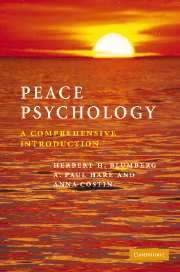Book contents
- Frontmatter
- Contents
- Preface
- Acknowledgements
- The scope, structure and content of this book
- Part I Introduction
- Part II Interdisciplinary practice
- Part III Primary psychological topics
- Part IV Core topics in peace and environmental studies
- 9 Conflict resolution
- 10 Emergency decisions, crisis management and the effects of conflicts
- 11 Nonviolence and peace movements
- 12 Peacemaking, wars and crises
- 13 The Middle East, Russia and other specific areas
- 14 Sustainable development
- Part V Terrorism
- References
- Index
12 - Peacemaking, wars and crises
Published online by Cambridge University Press: 05 June 2012
- Frontmatter
- Contents
- Preface
- Acknowledgements
- The scope, structure and content of this book
- Part I Introduction
- Part II Interdisciplinary practice
- Part III Primary psychological topics
- Part IV Core topics in peace and environmental studies
- 9 Conflict resolution
- 10 Emergency decisions, crisis management and the effects of conflicts
- 11 Nonviolence and peace movements
- 12 Peacemaking, wars and crises
- 13 The Middle East, Russia and other specific areas
- 14 Sustainable development
- Part V Terrorism
- References
- Index
Summary
How to address both direct and institutionalized violence represents one of humanity's major concerns. The sections of the present chapter pertain to the nature of war (including ethnic and intrastate conflict), historical perspectives, peacekeeping and stressors on peacekeepers, bargaining and diplomacy, and peacemaking and peacebuilding.
The nature of war
Arguing that the cultural basis for war should be examined statistically rather than assumed, Henderson (1997) examined the relationships among cultural factors, proximity and the onset of interstate war (using data for pairs of nations from 1820 to 1989). Cultural factors had a particularly strong impact on the likelihood of war, with the most dangerous dyads being ‘religiously dissimilar, territorially contiguous [i.e. neighbouring], and ethnically similar pairs of states’ (Henderson, 1997: 666). For discussion of a variety of theories regarding the origins of warfare in primitive societies – including the view that war evolved as a male-coalitional reproductive strategy – see van der Denner (1995).
Some justice in the world is evident in White's (1990) finding that, since 1914 at least, aggressor nations have usually lost in terms of their own self-interest. This has mainly been because of unexpected (albeit predictable) resistance by the victims and intervention by other countries. That is, aggressors typically misperceive such matters. They are, however, correct if they assume that they will be more likely to prevail if the target fails to receive third-party help. The net result may be a tendency towards small wars against the relatively defenceless (Gartner and Siverson, 1996).
- Type
- Chapter
- Information
- Peace PsychologyA Comprehensive Introduction, pp. 149 - 161Publisher: Cambridge University PressPrint publication year: 2006

